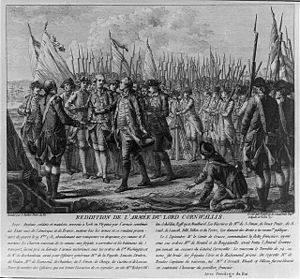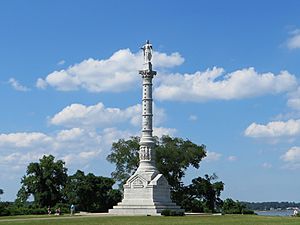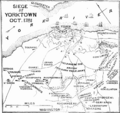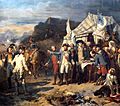Battle of Yorktown facts for kids
Quick facts for kids Battle of Yorktown |
|||||||
|---|---|---|---|---|---|---|---|
| Part of the Yorktown Campaign Part of the American Revolutionary War |
|||||||
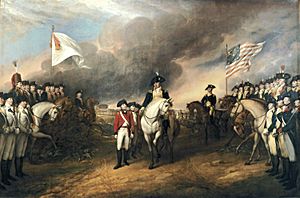 Surrender of Lord Cornwallis by John Trumbull, depicts the British surrendering to Benjamin Lincoln, flanked by French (left) and American troops. Oil on canvas, 1820. |
|||||||
|
|||||||
| Belligerents | |||||||
|
|
|
||||||
| Commanders and leaders | |||||||
|
|
|
||||||
| Strength | |||||||
|
Americans: 8,000–9,000 men
French: 7,500–8,800 men and 29 warships Total: 15,500–17,800 (fewer engaged) |
British: 7,000+ German: Fewer than 3,000Total: 9,000–10,000 |
||||||
| Casualties and losses | |||||||
| 88 killed 301 wounded |
142–309 killed; 326–595 wounded prisoners; 7,416–7,685 captured |
||||||
The Battle of Yorktown, also known as the Siege of Yorktown, was fought from September 28 to October 19, 1781. It was the last major land battle of the American Revolutionary War. The Continental Army, led by George Washington, won a big victory. They defeated the British Army, led by Lord Charles Cornwallis. Cornwallis had to surrender after being surrounded by Washington's army.
The Americans got help from the French. Their forces were led by the Comte de Rochambeau. The battle happened in Yorktown, Virginia, near the York River. The French navy defeated a British fleet. This trapped Cornwallis, forcing him to surrender to the French and American armies. This victory led to the Treaty of Paris in 1783. This treaty officially ended the war two years later.
Contents
Why the Battle Happened
British Strategy in the South
British General Lord Cornwallis had fought Americans since 1776. He believed the Americans could not beat the British army in battle. In 1778, he went back to England to care for his wife. She passed away in 1779. A few months later, he returned to America.
While he was away, Britain changed its war plan. Before, they focused on defeating Washington's army. But now, France had joined the Americans. This made the conflict a world war. France and Spain were fighting Britain. So, Britain had to move troops from North America to defend other places. The new plan was to win back the Southern colonies. They started with Georgia. Britain thought many people in the South were loyal to them. They planned to move north through The Carolinas to Virginia Colony.
Generals and Their Plans
When Cornwallis arrived in New York City, he became second-in-command to Henry Clinton. The two generals did not trust each other. Clinton believed Washington would attack him in New York. He was afraid to send troops home. He also worried about relying too much on Loyalist soldiers.
Cornwallis was ready to fight with the troops he had. Clinton suspected Cornwallis wanted to take his command. In fact, Cornwallis had permission to replace Clinton if Clinton kept threatening to quit.
Clinton sent Cornwallis south to recapture Charleston, South Carolina. This was part of the new plan. Soon, Cornwallis started acting on his own. Clinton stayed safe in New York City. Cornwallis did not play it safe. He attacked the American army under Horatio Gates without orders. He almost completely destroyed the Americans.
Cornwallis Moves to Yorktown
Cornwallis moved carelessly. He left American units, like the one led by Francis Marion, behind him. American General Nathanael Greene noticed this. Greene split his army into smaller groups to bother Cornwallis. The two armies finally met at the Battle of Guilford Court House. Neither side won clearly.
During this time, Cornwallis did not send updates to Clinton. After Guilford Court House, Cornwallis went to the North Carolina coast to rest his men. Then, again without orders, he marched north to Virginia. Clinton was frustrated. He sent Cornwallis many confusing messages. Most were suggestions, not direct orders. But he did order Cornwallis to find a strong defensive spot. This was so the British navy could pick him up. Cornwallis chose Yorktown. His men started building defenses there in August 1781. They waited for the navy.
French and American Plan
In New York, Washington learned that French Admiral François Joseph Paul de Grasse was sailing north. He was coming from the West Indies. Rochambeau convinced Washington they could attack and defeat Cornwallis. The two commanders began marching south. They planned to meet de Grasse's 27 ships and 3,200 troops.
Clinton found out about this. He sent a British naval fleet to the Chesapeake Bay to stop them. But the French and Americans arrived first. In the Battle of the Chesapeake, the French navy forced the British ships back to New York City.
Clinton warned Cornwallis in early September that American and French troops were coming. But he promised Cornwallis help by sea. Clinton did not know about the French naval victory. He didn't realize he couldn't rescue Cornwallis by sea. By the end of September, Washington and Rochambeau had surrounded Yorktown. Cornwallis got another message from Clinton in late September. It said help was on the way. Cornwallis was misled. He thought he only had to hold out for a few days.
The Siege of Yorktown

After the French and British fleets clashed, a smaller French squadron arrived. It carried the French army's heavy artillery. Now, the French and Americans had bigger guns than Cornwallis had behind his earthen fortifications.
The Americans and French marched from Williamsburg, Virginia. They arrived at Yorktown on September 28, 1781. They surrounded the British defenses in a Semicircle. The York River completed the circle. Cornwallis made the first move. He left his outer defenses, which were made of four redoubts. Washington and Rochambeau thought this was a mistake. They sent troops to take over these outer defenses.
The Americans and French began their siege operations on September 30. They started on the east side. By October 9, they were close enough to start firing their cannons. This is called a bombardment. The Americans and French attacked two of the redoubts on October 14. They forced the British back even further. By then, it was clear the British could not hold out much longer. On October 16, the British attacked two redoubts they had left. They spiked the guns, making them useless. At the same time, Cornwallis tried to sneak past the guards to Gloucester (now Gloucester Point, Virginia) across the river. But a storm turned him back.
The Surrender
Finally, there was no sign of the help Clinton had promised. Cornwallis's army of 6,000 soldiers had to surrender.
About 500 British soldiers were killed or wounded. The French had 200 casualties, and the Americans had 80. The Americans and French captured 240 cannons. They also took a large supply of small arms and ammunition, plus other equipment.
General Cornwallis did not attend the surrender ceremony. He claimed to be sick. He sent General Charles O'Hara to surrender for him. O'Hara first tried to surrender to Comte de Rochambeau. Rochambeau told him to surrender to General Washington. Washington, in turn, told him to surrender to General Benjamin Lincoln. Lincoln accepted O'Hara's sword.
As the British soldiers marched out of the fortress, they stacked their guns. Their band played a song called "The World Turned Upside Down." When Lord North, the British Prime Minister, heard the news, he cried out, "Oh God, it is all over!"
What Happened After Yorktown
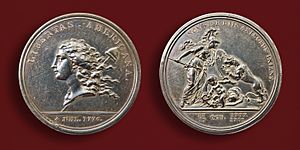
The battles of Saratoga in 1777 and Yorktown in 1781 were major turning points. Both were American victories over the British. But they had very different results. The British loss at Saratoga made the war last longer. The battle at Yorktown showed the war was ending. Saratoga convinced the French to join the Americans. Yorktown was a joint victory by the French and Americans. France and its allies kept fighting for two more years. But there was little fighting on the American continent after Yorktown. The Treaty of Paris (1783) officially ended the war.
Yorktown Victory Monument
Five days after the British surrendered, Congress passed a resolution. They agreed to build a monument. This monument would honor those who fought in the battle. The government began building the monument in 1881.
Interesting Facts About the Battle of Yorktown
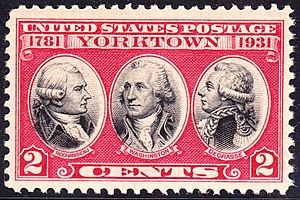
- 60 French soldiers died and 194 were injured.
- 28 Americans died and 107 were wounded.
- 156 British soldiers were killed. 326 were wounded, and 70 were missing.
- The battle lasted about 20 days.
- George Washington refused to accept one part of the surrender terms. This part would have protected American Loyalists.
- Many of Cornwallis's soldiers got Malaria. This was due to the marshlands in eastern Virginia. Many soldiers could not fight because of this illness.
- Cornwallis refused to go to the surrender ceremony. He said he was sick. Brigadier General Charles O'Hara led the British army onto the field instead.
- The siege of Yorktown is sometimes called "the German battle" in German history books. This is because Germans played big roles in all three armies. They made up about one-third of all the forces.
Images for kids
-
National Park Service map of the W3R Route
-
Siège de Yorktown by Auguste Couder, c. 1836. Rochambeau and Washington giving their last orders before the battle.
See also
 In Spanish: Batalla de Yorktown (1781) para niños
In Spanish: Batalla de Yorktown (1781) para niños


